One of my favorite men’s clothing stores is Bonobos. They do something cool. They don’t have any inventory. I almost always loathe a business that makes it hard to take my money, but Bonobos doesn’t allow you to buy anything in the store. You can try everything on in the store. You can find the perfect fit. And then, they’ll help you order it online, or you can go home and order it yourself.
Bonobos found the model so successful that Walmart recently purchased them for $310M (I’m keeping my fingers crossed that the good folks at Walmart are smart enough to let a great thing keep being great without too much interference!)
Nordstrom just announced they’re trying something similar. They’re testing out concept stores that shrink to 3,000 sq ft (from their standard size of 140,000 sq ft) and will use the Bonobos model of having no inventory (though they will, of course, have plenty of wine, beer, and espresso).
It makes me think about retail and beyond and something we’ve discussed in many previous tidbits.
What is the actual value proposition of a retailer (or any business for that matter?)
What are people buying from them? Is it expertise, relationship, advice, product, price, specific brand, the experience of being in the shop, etc.?
When you think about it, any retail store is made up of the same few elements. At the most basic level, you’ve got inventory (either in a particular price range or spanning from very inexpensive to very expensive), you’ve got staff on the floor to help customers, you’ve got staff to help customers check-out and pay.
The differences between retail experiences, then, are in how they choose to focus on these elements. Walmart still lives by Sam Walton’s vision of giving a great selection to people at the lowest cost, and so the focus is on inventory in a modest price range. There is far less focus on the ensuring that each member of the floor staff can help every customer find the perfect fitting product for them.
We’ve seen Amazon preparing to launch an experiment that prioritizes speed of shopping at physical locations, with their “no-cashier” concept stores. Walk in, grab what you want, and walk out.
Nordstroms, on the other hand, is focused on creating great relationships between their floor staff and their clients–they don’t need to have Walmart’s single-minded focus on having the lowest price or inventory selection, so their competitive advantage is much more tied to the expertise of their product consultants.
The point isn’t that there is a right model–rather, that when considering where to invest or where to focus, it’s imperative to think about what elements most naturally tie into what your customers expect from you.
If your customers expect the lowest price, then it doesn’t matter how innovative you are in your service offering. If they expect world class service from their product consultants, they don’t need that to come with the lowest price. If they just want to have something now instead of waiting two days for Amazon Prime delivery, then the ability to walk in and walk out as quickly as possible trumps both service and price.
Nordstrom ‘s experiment is an extreme (and we’re betting extremely successful) example of this lesson in action. These concept stores are betting that their customers don’t need to walk out of the store with a product the same day, but rather they want to walk out feeling like they were able to select the absolute best products based on their style and preferences. These stores will almost certainly be staffed with the true superstars of the Nordstrom product advisory team because they are 90% of the draw to these stores.
With that in mind, the most important question of all for companies is:
What elements of your customer experience are most important to YOUR customers and how can tweak your business to appeal to those elements?
Your Challenge For This Week: Ask everyone on your executive team to write down the top 3-5 most important elements of the customer’s experience.
Then, ask them to write down exactly how you’re meeting or exceeding those expectations.
See how much commonality you get amongst people and departments. Are things congruent between sales, marketing, operations, and service? Or is everyone all over the map?
Best,
Noah
P.S. As a bonus, Shawn and I discussed The Expectations Gap on this week’s edition of The Evergreen Show which is available here. It’s a slightly different take on the same issue discussed above, in that there is always a price to pay when there is a difference between what the customer expects and what they get. Whether you’re trying to minimize that price or maximize the opportunity, you need to start with an awareness of what they want and ensure that your delivery of it matches up!
